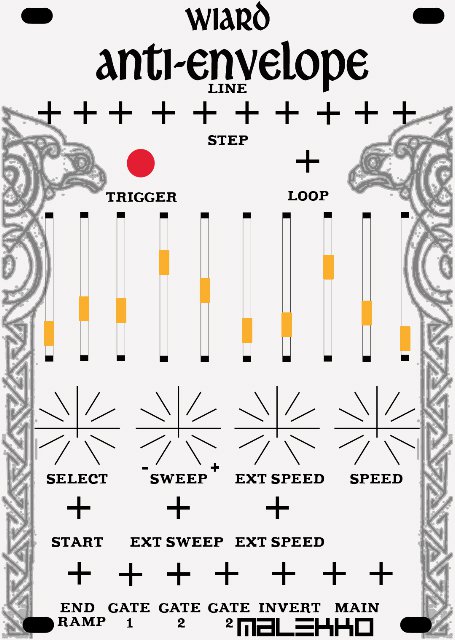liste des modules Malekko Wiard 300
http://www.muffwiggler.com/forum/viewtopic.php?p=159483#159483
Posted: Fri Jan 22, 2010 2:30 Post subject: More information on this module Reply with quote Add User to Ignore List The Anti-Envelope started life a long time ago as the analog tracking generator here:
http://www.musicsynthesizer.com/DIY/Grant/CVtwister.html https://web.archive.org/web/20130420233648/http://www.musicsynthesizer.com/DIY/Grant/CVtwister.html
Over the last nine years I have continued to expand on the idea and add additional features. BUT this is an experimental device. There has never been anything exactly like it before now and it's full potential will have to be discovered by the user. You are an electronic music pioneer!
This module does a LOT of things. It is still a comparator string, but I have added controls to make it behave more like a step sequencer. The advantage is that what would otherwise be difficult digitally, becomes very simple in analog. For example:
Straight step = up ramp Reverse step = down ramp "pendulum" (back and forth) = triangle wave Sub-sequences (using parts of larger sequence) = change amplitude and offset of sweep wave.
The first section is a linear sweep wave generator, which can run oneshot or cycle. The sweep rate is externally voltage controllable. This is coupled to the second section (quantizer) by a Buchla type +/- bipolar control so the number of stages and direction is controlled by this and the "Select" setting.
The interpolation function is now switched on a per stage basis instead of being global as in the first draft. So the switches determine if the change from one stage to the next is a step or straight line function. This is a DC function and not time dependent like a "slew limiter". This means the straight line is generated the same even if the stages are being swept manually or "scrubbed" like with old tape reels. The switches have their own output, so they can be used like a rhythm programmer with the Gate 2 output. This bus can be disconnected from the interpolation function. The interpolation function can be controlled externally, with what and why I don't know. A manual pushbutton will do some wild stuff.
To complete the illusion of a digital sequencer, we need a clock function, that outputs a pulse when any stage changes. In this case, this is done with a "burst generator" which is logic that detects whenever the sweep voltage crosses to a new stage by any method, swept, stepped or scrubbed. The Gate 1 pulses are 2 milliseconds wide, the same as the shortest setting on the Envelator and can be run directly to a Borg or Boogie in a pinch.
The preferred method is to use these pulses to trigger one or more Envelators.
So this is what I know it will do for sure:
1. 10 place quantizer 2. Analog Tracking Generator for control voltage remapping 3. 10 stage sequencer 4. 10 segment envelope 5. Rhythm programmer 6. Burst generator (voltage change to pulse convertor) 7. Mixture of stepped and straight line functions like MARF 8. Audio rate waveshaper (run a VCO into select input, program waveform on sliders)
Using a second module in parallel with the first would allow you to program segment time for each of 10 segments. Using one shot mode, this will give a 10 segment envelope with programable level and time for each segment.
Let me emphasize again that this is a pioneering module, even I don't know everything it can do, but it is designed so the faceplate interface is simple enough to make exploration fun and even the beginning synthesist will find it usable.
The Envelators should be in stores very soon and this module will be shipping a couple months after.
